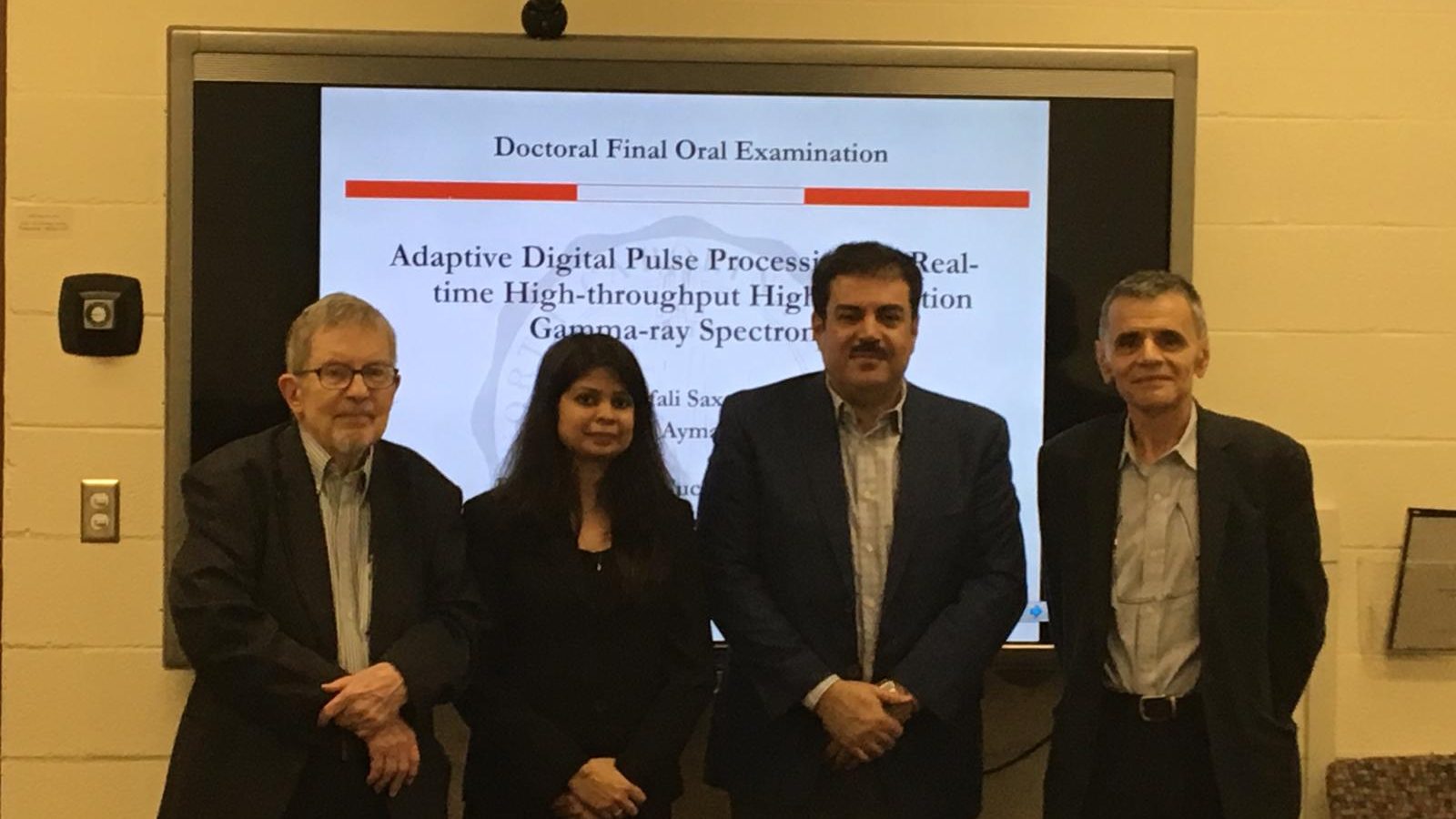On April 26, Shefali Saxena successfully defended her PhD dissertation, Adaptive Digital Pulse Processing for Real-time High-throughput High- resolution Gamma-ray Spectrometry. Shefali’s committee consisted of her chair, Ayman Hawari, and members, Albert Young, Bernard Wehring, and Kostadin Ivanov.
Abstract
Saxena, Shefali. Adaptive Digital Pulse Processing for Real-time High-throughput High- resolution Gamma-ray Spectrometry (Under the direction of Dr. Ayman Hawari).
A high-resolution high-throughput real-time adaptive digital pulse processing system is developed for high count rate applications. High count rate applications in spent nuclear fuel assay, nuclear safeguards, and advanced reactors (e.g., pebble bed reactors) require high-resolution, high-throughput gamma-ray spectrometry for the accurate estimation of quantities like the fuel isotopic content and burn-up. An advanced instrumentation technique is required to handle such high-count rates while preserving high spectroscopic performance. Traditional nuclear instrumentation designed for gamma-ray spectrometry is composed of analog signal processing modules that suffer from various issues such as pulse pile-up, dead-time, electronic noise, and temperature sensitivity, which degrade spectroscopic performance. Advances in digital systems make it possible to implement optimum filters to achieve improved signal to noise ratio as compared to traditional analog systems. Using the field programmable gate arrays (FPGAs), the system can operate in real time with more flexibility and considers the attributes of the generated signal on a pulse-by-pulse basis to enhance the spectroscopic performance.
In this work, a high purity germanium detector (HPGe) was used for the measurements, which provides excellent energy resolution over a wide range of gamma-ray energies. At high count rate conditions, the considerations and requirements of signal to noise ratio, ballistic deficit, and pile-up impose a trade-off between throughput rate and energy resolution using traditional pulse processing. Adaptive digital pulse processing algorithms were developed which include a pulse deconvolver, a trapezoid shaping filter with the adaption of shaping parameters, a timing filter, a baseline restorer and a pile-up rejecter. A digital pulse deconvolution technique was developed to reconstruct the original detector signal from the preamplifier signal, which reduces the resolution deterioration due to pulse pile-up. The radiation detector output pulses are distributed randomly following an exponential distribution. The trapezoid filter rise-time adaption algorithm was developed based on the given interval distribution which selects the rise time for each shaping filter from the optimum one to the lowest possible one based on the time interval between the successive pulses. Also, the flattop time was made adaptive based on the ZCD time for each individual preamplifier pulse, which is correlated to the charge collection time.
The developed adaptive digital pulse processing algorithms were implemented on a reconfigurable FPGA for real-time pulse processing. Experimental measurements were performed with a high-radioactivity 137Cs source under varying count-rate and pulse shaping conditions using HPGe detectors equipped with resistive feedback (RC) and transistor reset preamplifiers (TRP). The HPGe detector’s preamplifier pulses were sampled at a high frequency by a digitizer and digitally processed in real-time on a pulse-by-pulse basis using the developed algorithms. The results demonstrate that when using a TRP, adaptive digital signal processing allows handling 106 counts/s (cps). Experimental results have shown that the implementation of the developed deconvolution approach limits resolution deterioration at high count rates and the adaptive shaping algorithm based on the charge collection time and time separation between input pulses enhances the throughput rates. The maximum throughput rate achievable is 458 kcps, which is 5-10 times better compared to the traditional analog and digital systems. In addition, the typical energy resolution of the HPGe detector is maintained with the high throughput performance. Thus, this work incorporates the physics of the radiation emission phenomenon with advanced instrumentation to develop a high-resolution high-throughput system capable of handling ultra-high-count rates in various applications of nuclear science and technology.

